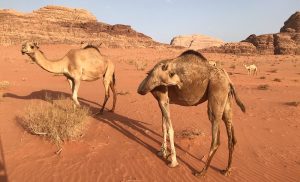When Is The Best Time To Visit The Chobe National Park?
The best time to visit the Chobe National Park is from May to early November when most visitors go to the Chobe for its famous dry-season game viewing. Large groups of water-dependent elephants and buffalo can be spotted during this period along the banks of the Chobe River, as well as in the park’s central Savuti region.
May, June, and July are bone-dry in the Chobe National Park with cold nights, but temperatures rise rapidly as the rainy season approaches. August, September, and October offer sensational game viewing, but in hot conditions. Chobe National Park is truly a year-round destination and no matter what month you decide to visit, you will have an exceptional safari experience.
Month By Month Guide For Travelling To Chobe National Park:
Visiting Chobe National Park From January To March
January
In the Chobe National Park is the Green season and the bush is full of new life. It is not considered peak season when visiting the Chobe National Park and you could take advantage of reduced rates on accommodation. The riverbeds in Chobe receive more rain than anywhere else in Botswana during this summer month.
February
This is a month for spectacular thunderstorms while on a Chobe Safari. These showers usually last a few short hours, leaving enough clear skies during the day. Birding is excellent in February in all parts of the park, as all the migrant bird species have made their way to the Chobe by this time. This is a high-risk time for contracting malaria, so it’s best to take the correct precautions.
March
signals the start of autumn in the Chobe and is the last month of the summer rains. This is a great time to take in the beautiful scenery as the landscape is lush, but wildlife can be more difficult to spot during this time of year.
Visiting Chobe National Park From April To May
April is the start of autumn in the Chobe and the best way to explore this park is by boat, as large herds of elephant and buffalo come to the Chobe River to quench their thirst. Zebra and wildebeest begin their return migration, and the bush begins to dry out.
The riverfront area is very popular in the dry months, especially in May which is considered the best time to visit the Chobe National Park. Temperatures are cooler in the mornings and the Chobe River and Kasane start to get busy as peak season approaches.
Travelling To The Chobe National Park From June To August
June
It is the beginning of peak season and is the best time for a safari in the Chobe National Park and to experience luxury Lodges in Chobe like Chobe Game Lodge. It does get cold at night during this winter period and the temperature can drop below zero, so it’s best to pack warmer clothes for the evenings.
July
is the coldest month if you’re planning a safari in the Chobe, but waterholes are frequented by an abundance of wildlife. The elephant herds continue to gather in their masses on the banks of the Chobe River, and there is a greater chance of seeing Africa’s endangered ‘painted wolves’, wild dog.
The dry season continues during August in the Chobe National Park. This is the best time to visit the Chobe National Park for fisherman, as the annual barbell run takes place in the Kasai channel.
Visiting Chobe National Park From September To October
September
is the first month of spring in the Chobe and it starts to get hotter in the daytime. The first bird migrants return to the park which makes this month the best time to visit the Chobe National Park for birding safaris. The Chobe and Linyati are good regions to visit for big game sightings in September, and tiger fishing is also very popular in the Chobe River during this time.
October
is one of the warmest months in the Chobe National Park and the elephant population will soon disperse from water sources as things quieten down for this low shoulder season. The Chobe National Park receives little rain during this month and it’s an ideal time to avoid the crowds and enjoy reduced rates.
Travelling To The Chobe National Park In November & December
November
the weather is mostly hot and clear, and the Green Season begins. The first set of rains settle on the dusty, dry landscape, and acacia trees, baobab and sausage trees begin to flower, triggering calving season.
December
It is a hot and humid month that receives quite a bit of rain. December sees the start of the zebra migration, as hundreds of these animals make their way south through ancient migratory routes from the Chobe to the Kalahari region.
Ready To Start Planning Your Chobe Safari?
Chat with someone who’s been there. Get in touch with one of our Abunda Discoveries Uganda Experts to help tailor-make a trip to the Chobe National Park that’s right for you.




